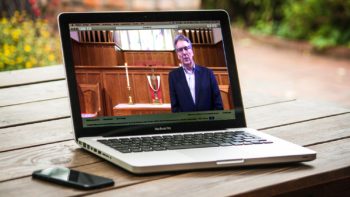History of the Disciples
Early History
The Christian Church (Disciples of Christ) grew out of two movements seeking Christian unity that sprang up almost simultaneously in western Pennsylvania and Kentucky – movements that were backlashes against the rigid denominationalism of the early 1800s.
Thomas and Alexander Campbell, a Presbyterian Scotch-Irish immigrant father and son in Pennsylvania, rebelled against the dogmatic sectarianism that kept members of different denominations – and even factions within the same denomination – from partaking of the Lord’s Supper together. Walter Scott, an immigrant from Scotland, was a successful evangelist of the resulting Campbell movement as it separated from the Baptists.
Barton W. Stone, a fifth-generation American in Kentucky and also a Presbyterian, objected to the use of creeds as tests of “fellowship” within the church, which were a cause of disunity, especially at the Lord’s table. He was a key participant in the Restoration Movement following the Cane Ridge Revival of 1801 near Paris, KY.
“Christians,” the name adopted by Stone’s movement, represented what he felt to be a shedding of denominational labels in favor of a scriptural and inclusive term. Campbell had similar reasons for settling on “Disciples of Christ” but he felt the term “Disciples” less presumptuous than “Christians.” (For an introduction to some of their ideas, see the Last Will and Testament of the Springfield Presbytery – 1804 or the Declaration and Address – 1809.)
The aims and practices of the two groups were similar, and the Campbell and Stone movements united in 1832 in Lexington, KY after about a quarter of a century of separate development. (For key dates and more detail, go to the Disciples of Christ Historical Societywebsite.)
The founders of the Christian Church hoped to restore Christian unity by returning to New Testament faith and practices. But the church found that even this led to division. One group which opposed practices not specifically authorized by the New Testament, such as instrumental music in the church and organized missionary activity, gradually pulled away. That group finally was listed separately in the 1906 federal religious census as the “Churches of Christ.”
Another group began a separation in 1926 over what it felt were too-liberal policies on the mission field in the practice of baptism. More than 40 years later (1967-69) some 3,000 of those congregations formally withdrew at the time of Disciples restructure. They refer to themselves as the Christian Churches/Churches of Christ.
U.S. Presidents who had Disciple connections | Important dates in Disciple history
A Heritage of Openness and Ecumenism
The Disciples have a long heritage of openness to other Christian traditions having come into existence as a 19th century protest movement against denominational exclusiveness. At the local level and beyond, Disciples are frequently involved in cooperative and ecumenical work.
In 1910, the Disciples established the Council on Christian Unity, the first denomination in the world to have an organization devoted to the pursuit of Christian unity. Disciples helped organize the National and World Councils of Churches. General Minister and President Sharon Watkins is a member of the WCC governing body and also an officer on the NCC board (2013). The denomination also contributed the first lay president of the National Council (1960-63), Indiana industrialist J. Irwin Miller.
The Rev. Paul A. Crow Jr., retired president of the Council on Christian Unity, the Rev. Michael K. Kinnamon, now retired from the faculty at Seattle University, and the Rev. Patrice Rosner are Disciples who served as chief executives of the Consultation on Church Union – now Churches Uniting in Christ (CUIC) – which is striving for visible unity.
In 1977, the Disciples of Christ (through the Disciples Ecumenical Consultative Council) have been engaged with the Roman Catholic Church in an official international dialogue, holding annual meetings, to explore the possibility of realizing full visible unity in Christ. The current phase of this dialogue, begun in 2013, is focusing on the theme , “Christians Formed and Transformed by the Eucharist.”
Disciples have given leadership to the establishment of Christian Churches Together in the U.S.A. (CCT) that brings together Catholics, Protestants, Orthodox, Evangelicals and Pentecostal Christians to seek to make a common witness in the United States. The Rev. Richard L. Hamm, former General Minister and President, was CCT’s first full-time executive.
In 1989, the Disciples and the United Church of Christ declared that “a relationship of full communion now exists between our two churches.” The ecumenical partnership rests on five pillars of acceptance and cooperation: a common confession of Christ; mutual recognition of members; common celebration of the Lord’s Supper/Holy Communion; mutual recognition and reconciliation of ordained ministries; and common commitment to mission.
Joint work between the Disciples’ Division of Overseas Ministries and the UCC’s Wider Church Ministries (formerly known as United Church Board for World Ministries), dates from 1967. World mission for both churches is now carried out by the Common Global Ministries Board, established in 1995.
In 1999, an official dialogue was initiated between the Christian Church (Disciples of Christ), the Christian Church/Churches of Christ, and the Churches of Christ to explore greater understanding and develop greater trust among these three “streams” of the Stone-Campbell Movement.
In 2013, Disciples Home Missions and the UCC began to develop common programs in the areas of Children and Family Ministries and youth and young adult ministry. In addition, key executives of both denominations took the necessary training to have mutual ministerial standing in both denominations.
In the wider ecumenical movement, Disciples have held theological conversations with the Roman Catholic Church and with the World Communion of Reformed Churches.
The tapestry of today
The Christian Church (Disciples of Christ) is a North American denomination. North America has long been racially and culturally diverse but church life is not always integrated. The Christian Church (Disciples of Christ) participates in the racial and cultural diversity of North America, including in its membership European Americans, African Americans, Hispanic Americans and Pacific Island/Asian Americans. Disciples are working to become a pro-reconciling anti-racist church. We also have brothers and sisters in Canada who joined our movement with a slightly different history.



